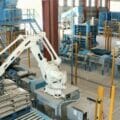~ The benefits of making incremental changes in IT infrastructure ~
According to a global study from infrastructure monitoring company LogicMonitor, many IT departments had to act quickly to transition to remote working at the start of the pandemic. In the study, 70 per cent of IT professionals said they found it challenging to adapt, support a remote workforce and keep data secure. Transitioning to remote working is just one of the reasons that some businesses should review their IT infrastructure. Here Paul Holding, solutions architect at IT integration provider Ripley Solutions explains why and how businesses can effectively upgrade their IT infrastructure.
Most businesses require some form of IT infrastructure to operate. However, because it is not always visible, IT often operates in the background unnoticed — much like the plumbing in your house. Sometimes we only decide to learn how the plumbing works when it’s too late, so we must act quickly to fix it and the same could be said for IT.
When the pandemic began and we were instructed to work from home, businesses were under pressure to quickly deliver IT solutions that enabled people to access what they need remotely. Just like we often assume our plumbing will always work, some smaller enterprises rarely reviewed IT infrastructure and its performance before lockdown. However, as businesses consider their COVID exit strategy and implement long term IT solutions to continue remote working, it is clear we must pay more attention to our infrastructure.
Why change?
It’s important that IT infrastructure always meets the needs of the business — if it doesn’t suit employees, or costs too much in money or time, it might be time for an upgrade. Remote working may have exposed some of these issues and as a result employees are driving change, explaining that they cannot work effectively using existing systems.
Some might find that IT holds the business back in other ways. For example, as more businesses look at adopting cloud services, they may see costs increasing — paying a fee for every employee can be costly and is not the most effective way of using the cloud. Alternatively, costs may be high because the system is unreliable, and businesses are spending more time fighting fires than strategizing about the future.
On some occasions, businesses might not know that they need an upgrade until it’s too late. Equipment failures and cybersecurity attacks are costly ways to discover there are the problems with the system.
Reviewing infrastructure
Businesses are integrating advanced technologies, such as Internet of Things (IoT) devices, cloud computing, analytics and advanced sensors, into their operations to realise Industry 4.0. By digitalising processes, businesses can use analysed data to make more informed decisions, increase productivity and gain full visibility over operations.
There’s a common misconception that businesses must invest in all the latest “shiny” technologies to truly realise Industry 4.0. In reality, every company will experience a different journey to digitalisation and it doesn’t require an overhaul of operations.
To decide where to start, businesses should review current IT infrastructure, reviewing if employees are satisfied with the current set up, if it’s reliable and the potential risks. Businesses should ask what will happen if the IT systems stop working — while many small companies say it’ll never happen to us, it’s not necessarily true. After assessing the current performance of IT infrastructure, businesses should outline business objectives, looking at what they want to achieve from an upgrade. They can also work with an IT specialist to determine what works well in a current infrastructure and where they can make improvements to determine what an upgrade could look like.
Once a business has worked out where it wants to be, it can work backwards on how to get there. That might involve one small project to address a business pain point, or a strategic plan to enable a complex change in the business. If looking to make a complex change, IT consultants can help to develop a roadmap to digitalisation, outlining the incremental steps needed to achieve the result.
Out of sight shouldn’t mean out of mind. We often encourage homeowners to keep an eye on their plumbing to avoid costly problems, businesses should do the same with their IT infrastructure. Instead of waiting until something goes wrong to make changes, businesses should take the time to proactively review their infrastructure and explore how they can take the first steps to digitalisation.
Ripley Solutions can help to assess your current IT infrastructure, develop a roadmap to digitalisation and install new technologies to improve your operations. To set up a consultation, contact Ripley Solutions on [email protected].








